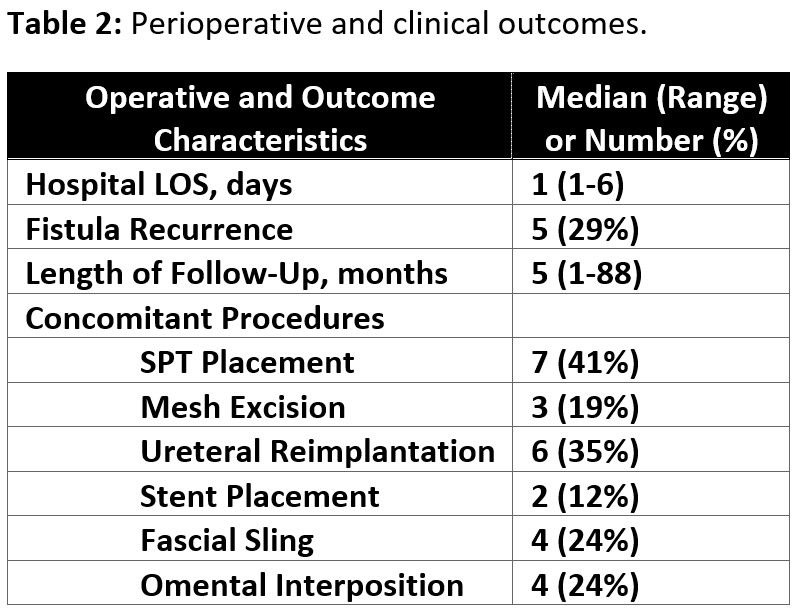Back
Poster, Podium & Video Sessions
Video
V01: Upper Tract Reconstruction
V01-05: Single Institutional Experience with Robotic-Assisted Laparoscopic Urinary Tract Fistula Repair
Friday, May 13, 2022
7:40 AM – 7:50 AM
Location: Video Abstracts Theater
Margaret Higgins*, Gary Shahinyan, Brian Flynn, Aurora, CO
- MH
Video Presenter(s)
Introduction: Urinary tract fistulas (UTF) are a diverse set of abnormal anatomical connections, most commonly from iatrogenic causes. They cause significant distress to the patient and usually require surgical repairs. Traditionally, repairs have been performed in an open fashion, but as minimally invasive techniques have become more widespread, the robotic-assisted laparoscopic (RAL) platform has been successfully employed in these complex repairs. The aim of our study is to highlight our institution’s recent experience with RAL UTF repairs and to highlight our surgical technique in a representative case.
Methods: We retrospectively reviewed the medical records of all female patients who underwent RAL UTF repairs by a single surgeon. These included vesicovaginal (VVF), vesicouterine (VUF), vesicocervical (VCF), ureterovaginal (UVF), rectovaginal (RVF) and colovesical (CVF) fistula repairs. We analyzed patient demographics, fistula characteristics, perioperative factors, complications, and outcomes. The video highlights our RAL surgical technique for a representative UVF repair in a 33-year-old female who developed urine per vagina 4-5 days following a laparoscopic hysterectomy.
Results: 17 females underwent robotic fistula repairs between 12/2013 and 7/2021 (Table 1). 94% of the fistulas were iatrogenic with hysterectomy being the most common causative procedure. 53% of the fistulas were between the bladder and female organs, 24% were GI fistulas, and the remaining 24% were uterovaginal. All cases were completed robotically with only 1 intraoperative complication of a ureteral injury. Median hospital LOS was 1 day. All cases included a concomitant procedure (Table 2). At a median follow-up of 5 months, 5 patients had recurrences, signifying a 71% success rate. Of the 5 patients that recurred, 2 had hx of cancer and 1 had history of radiation while none in the non-recurrence group had oncological history. No other 90-day complications were recorded.
Conclusions: RAL approaches to UTFs offer feasible repairs with good success rates and low rate of complications.
Source of Funding: N/a


Methods: We retrospectively reviewed the medical records of all female patients who underwent RAL UTF repairs by a single surgeon. These included vesicovaginal (VVF), vesicouterine (VUF), vesicocervical (VCF), ureterovaginal (UVF), rectovaginal (RVF) and colovesical (CVF) fistula repairs. We analyzed patient demographics, fistula characteristics, perioperative factors, complications, and outcomes. The video highlights our RAL surgical technique for a representative UVF repair in a 33-year-old female who developed urine per vagina 4-5 days following a laparoscopic hysterectomy.
Results: 17 females underwent robotic fistula repairs between 12/2013 and 7/2021 (Table 1). 94% of the fistulas were iatrogenic with hysterectomy being the most common causative procedure. 53% of the fistulas were between the bladder and female organs, 24% were GI fistulas, and the remaining 24% were uterovaginal. All cases were completed robotically with only 1 intraoperative complication of a ureteral injury. Median hospital LOS was 1 day. All cases included a concomitant procedure (Table 2). At a median follow-up of 5 months, 5 patients had recurrences, signifying a 71% success rate. Of the 5 patients that recurred, 2 had hx of cancer and 1 had history of radiation while none in the non-recurrence group had oncological history. No other 90-day complications were recorded.
Conclusions: RAL approaches to UTFs offer feasible repairs with good success rates and low rate of complications.
Source of Funding: N/a



.jpg)
.jpg)